E.V. Gordon's Pearl
2024-1-1 8:37:16 PM UTC
Pearl
Edited by E.V. Gordon with contributions from J.R.R. Tolkien, published by Ida Gordon.

Front covers of prints 1,3,4,5 of Pearl. Image from the collection under The Hill

Spines of prints 1,3,4,5 of Pearl. Image from the collection under The Hill

Back covers of prints 1,3,4,5 of Pearl. Image from the collection under The Hill

Portion of Ida Gordon's Introduction thanking Tolkien. Image from the collection under The Hill
This article is an introduction to Pearl, edited by E.V. Gordon and published posthumously by Ida Gordon, with contributions from J.R.R. Tolkien. It is a Middle-english poem that is considered one of the most important surviving works of the English Medieval period. This edition, published in 1953 by the Oxford University Press, contains a contribution from professor Tolkien in part of the introduction - Form and Purpose in pages XI-XIX. Tolkien’s contribution was reprinted in Sir Gawain and the Green Knight, Pearl and Sir Orfeo (1975).
With elements of medieval allegory and from the dream vision genre, the poem is written in a North-West Midlands variety of Middle English and is highly—though not consistently—alliterative; there is, among other stylistic features, a complex system of stanza-linking. The poem survives in a single manuscript, and the real name of "The Pearl Poet" (or poets) is unknown. What is known today about the poet is general.
As J. R. R. Tolkien and E. V. Gordon, after reviewing the text's allusions, style, and themes, concluded in 1925:
"He was a man of serious and devout mind, though not without humour; he had an interest in theology, and some knowledge of it, though an amateur knowledge perhaps, rather than a professional; he had Latin and French and was well enough read in French books, both romantic and instructive; but his home was in the West Midlands of England; so much his language shows, and his metre, and his scenery."
E.V. Gordon was a contemporary of Tolkien’s, the two collaborated on Sir Gawain and the Green Knight, The Battle of Maldon, and An Introduction to Old Norse. Tolkien helped Gordon’s widow Ida bring Pearl to publication after Gordon unexpectedly died in 1938

First Editions of Tolkien and Gordon's collaborations. Image from the collection under The Hill

Second editions and reprints of Tolkien's and Gordon's collaborations. Image from the collection under The Hill
Pearl, 1st Edition Hardback, 1953

Front covers of the 1st Edition of Pearl. Image from the collection under The Hill

Front Jacket Flap of the First Printing. Image from the collection under The Hill

Frontispiece and Title Page of the First Printing. Image from the collection under The Hill

Copyright Page of the First Printing. Image from the collection under The Hill

Copyright Page of the 3rd Printing. Image from the collection under The Hill

Back Jacket Flap of the First Printing. Image from the collection under The Hill
Published June 11, 1953 in a run of 3000 copies. A hardback in a tan colored dust jacket with navy lettering and crest on the cover. It contains The frontispiece of The Dreamer lying on the Flowery Mound. The boards are navy with the OUP symbol on the spine. This 186 page translation was reprinted in this format two times, in 1958 and 1963.
The poem may be divided into three parts: an introduction (or "Prologue"), a dialogue between the two main characters in which the Pearl instructs the narrator, and a description of the New Jerusalem with the narrator's awakening.
Pearl, 2nd Edition Hardback, 1966

Front covers of the Second Edition of Pearl. Image from the collection under The Hill

Copyright Page of the Fourth Printing. Image from the collection under The Hill

Copyright Page of the Fifth Printing. Image from the collection under The Hill
Published in 1966 in nearly identical form to the 1st edition, but with a few minor changes if however so subtle. Published as a hardback in a cream/light blue colored dust jacket with navy lettering and crest on the cover. It still contains the frontispiece of The Dreamer lying on the Flowery Mound. The boards are navy with the OUP symbol on the spine. This edition was reprinted twice in 1970 and 1974 with an SBN and ISBN added to each.
Death and transience are major themes in the poem; outside of the Parable of the Workers in the Vineyard which we are presented in stanzas 42–60 we see notable reference to another biblical passage Matthew's Sermon on the Mount.
Pearl, 1st Paperback Edition, 1980

Front cover of the Paperback Edition. Image from the collection under The Hill

Back cover of the Paperback Edition. Image from the collection under The Hill

Title Page of the Paperback Edition. Image from the collection under The Hill
Pearl was later printed as a paperback edition in 1980, text is identical to the hardback volumes with the same introduction, translation, and frontispiece. Published in a brown/coffee colored binding with white lettering and reviews of the poem on the back cover. It was also reprinted twice in 1986 and 1988.
Towards the close of the poem, we are given a hallucinatory description of the spiritual bliss which awaits the virtuous within this golden citadel situated on a hill of precious stones.
Conclusions
Pearl is and besides the symbolic, on a sheer formal level, it is almost astounding in its complexity, and is recognized to be, in the words of one prominent scholar, "the most highly wrought and intricately constructed poem in Middle English" (Bishop 27). It is 1212 lines long, and has 101 stanzas of 12 lines, each with the rhyme scheme ABABABABBCBC. Death and transience are major themes in the poem, and Gordon’s translation is a masterwork.
Tolkien and Gordon worked very closely while at Leeds and it’s safe to say that Tolkien’s influence on Gordon was quite strong. After Gordon arrived at Leeds, Tolkien wrote in his diary "Eric Valentine Gordon has come and got firmly established and is my devoted friend and pal."
Collecting Pearl is quite easy, if you do not care which printing you get of either the hardback or paperback editions. 1st and early printings are somewhat hard to come by, especially with a good, well preserved jacket, as many were discarded by libraries and other academic institutions of the time. The paperback is also easy to find, although finding volumes that are not listed with stock photos is a challenge.
For more information & Works Consulted
1. J.R.R. Tolkien A Descriptive Bibliography - Wayne G. Hammond with the assistance of Douglas A. Anderson (Oak Knoll)
2. JRR Tolkien Sir Gawain and the Green Knight, Pearl, & Sir Orfeo - Edited by Christopher Tolkien (HarperCollins)
3. Turville-Petre, Thorlac. The Alliterative Revival. Woodbridge: Brewer etc., 1977. pp. 126–129.
4. Nelles, William. "The Pearl-Poet". Cyclopedia of World Authors, fourth revised edition
5. Tolkien, J. R. R.; Gordon, E. V., eds. (1925). Sir Gawain and the Green Knight. Oxford: Clarendon
6. Shippey, T. A. (1982). The Road to Middle-Earth
7. Carpenter, Humphrey (2000). J. R. R. Tolkien
8. Christina Scull and Wayne G. Hammond, The J. R. R. Tolkien Companion & Guide
9. Douglas A. Anderson, ' "An Industrious Little Devil": E. V. Gordon as Friend and Collaborator with Tolkien', in Tolkien the Medievalist



















 8
8 3235
3235